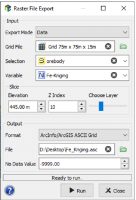Export Raster File
The Raster File Export functionality allows the export of variable located on a grid into an external file. This file can be either a georeferenced image (a .tif file) or a data file (GeoTIFF, ArcGIS, NetCDF or ZMap file).
-
Input:
-
Export Mode: Choose here in which mode you want to export your data.
- Image: In this mode, the generated file is a geolocalized image (a GeoTIFF file).
- Data: Selecting this mode, the generated file will contain both grid characteristics and variable values.
- Grid File: Click Grid File to open a Data Selector to select the grid which contains the variable you want to export. The grid can also be dragged and dropped directly from the Data tab. The input grid can be 2D or 3D.
- Selection: Choose a Selection variable to define which variable of the grid you want to export.
- Variable: The selected variable must be numerical.
-
- Slice: If the selected grid is 3D, select the Z Layer, i.e. the level (in Elevation or through the Z Index corresponding to the grid index), of the 3D grid that you want to export. You can interactively change the Z Layer by manipulating the slicer (Choose Layer).
-
Output:
-
Format: Choosing the Data mode, the selected variable can be exported in four different formats: GeoTIFF (*.tif), ArcGIS (ASCII grid file, *.asc), NetCDF file (*.nc) or ZMap file (*.zmap). Using the Image mode, the variable will be exported in an image file (GeoTIFF).
Note: ArcViewTM ArcGISTM are registered products from the Environmental System Research Institute (ESRI). NetCDF format is described on this website. ZMap is a trademark of Landmark Graphics Corporation.
- File: In the window file selector, choose the directory and name the File in which you want to save your variable. In the case of the Image mode, the color scale associated to the variable (visible in the variable properties) is automatically exported in a second file file_name_legend.tif. This one is not geolocalized.
- No Data Value: Define here the value written in your output file when the Isatis.neo variable value is set to undefined. By default, the program will store the undefined (N/A) values using the string -9999.
-


